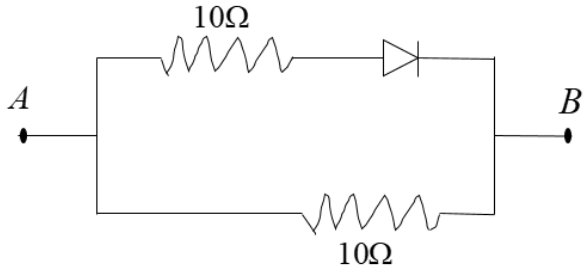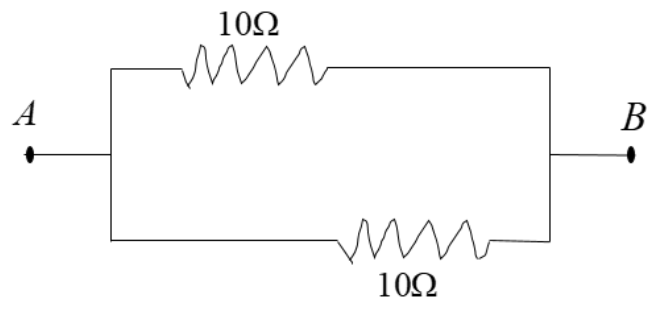
If ${{V}_{A}}$ and ${{V}_{B}}$ denote the potentials of A and B, then the equivalent resistance between A and B in the adjoint electric circuit is-

A). $10\Omega $ if ${{V}_{A}}>{{V}_{B}}$
B). $5\Omega $ if ${{V}_{A}}<{{V}_{B}}$
C). $5\Omega $ if ${{V}_{A}}>{{V}_{B}}$
D). $20\Omega $ if ${{V}_{A}}>{{V}_{B}}$

Answer
573k+ views
Hint: The diode will allow the current to pass only when it is forward biased. If the diode is not forward biased, then it will not allow current to flow through it. We will use this concept to solve the question.
Formula Used:
Resistances in series: ${{R}_{net}}={{R}_{1}}+{{R}_{2}}$
Resistances in parallel: ${{R}_{net}}=\dfrac{{{R}_{1}}{{R}_{2}}}{{{R}_{1}}+{{R}_{2}}}$
Complete step-by-step solution:
Here, there are various conditions given in the options. It basically boils down to whether ${{V}_{A}}>{{V}_{B}}$ or ${{V}_{A}}<{{V}_{B}}$.
We will apply these conditions to the circuits and see what is the behavior of the diode under these conditions.
Case-1: ${{V}_{A}}>{{V}_{B}}$:
Here, if we consider ${{V}_{A}}>{{V}_{B}}$, then we can say that the positive terminal of the diode is connected to the higher potential. This will make the diode forward biased and the diode will become a short circuit and will allow the current to flow through it. The diagram will be:

It can be seen clearly that the resistances $10\Omega $ and $10\Omega $ are in parallel. Hence, the net resistance between A and B will be:
${{R}_{AB}}=\dfrac{10\Omega }{2}=5\Omega $
Case-2: ${{V}_{A}}<{{V}_{B}}$:
In this case, the negative terminal of the diode is connected to the higher potential. This will make the diode reversed biased and the diode will become an open circuit. This will not allow any current to flow through the diode. The diagram will look like:

It can be seen clearly that the $10\Omega $ in the above branch becomes out of the circuit.
Hence, clearly, the resistance between A and B becomes:
${{R}_{AB}}=10\Omega $
Thus, ${{V}_{A}}>{{V}_{B}}$ $\Rightarrow {{R}_{AB}}=5\Omega $
& ${{V}_{A}}<{{V}_{B}}$ $\Rightarrow {{R}_{AB}}=10\Omega $
Thus clearly, the answer is an option (c).
Note: Forward biased diode acts as a short circuit in the branch. It allows current to easily flow through it. The reversed biased diode acts as an open circuit in the branch. It does not allow any current to flow through it.
Formula Used:
Resistances in series: ${{R}_{net}}={{R}_{1}}+{{R}_{2}}$
Resistances in parallel: ${{R}_{net}}=\dfrac{{{R}_{1}}{{R}_{2}}}{{{R}_{1}}+{{R}_{2}}}$
Complete step-by-step solution:
Here, there are various conditions given in the options. It basically boils down to whether ${{V}_{A}}>{{V}_{B}}$ or ${{V}_{A}}<{{V}_{B}}$.
We will apply these conditions to the circuits and see what is the behavior of the diode under these conditions.
Case-1: ${{V}_{A}}>{{V}_{B}}$:
Here, if we consider ${{V}_{A}}>{{V}_{B}}$, then we can say that the positive terminal of the diode is connected to the higher potential. This will make the diode forward biased and the diode will become a short circuit and will allow the current to flow through it. The diagram will be:

It can be seen clearly that the resistances $10\Omega $ and $10\Omega $ are in parallel. Hence, the net resistance between A and B will be:
${{R}_{AB}}=\dfrac{10\Omega }{2}=5\Omega $
Case-2: ${{V}_{A}}<{{V}_{B}}$:
In this case, the negative terminal of the diode is connected to the higher potential. This will make the diode reversed biased and the diode will become an open circuit. This will not allow any current to flow through the diode. The diagram will look like:

It can be seen clearly that the $10\Omega $ in the above branch becomes out of the circuit.
Hence, clearly, the resistance between A and B becomes:
${{R}_{AB}}=10\Omega $
Thus, ${{V}_{A}}>{{V}_{B}}$ $\Rightarrow {{R}_{AB}}=5\Omega $
& ${{V}_{A}}<{{V}_{B}}$ $\Rightarrow {{R}_{AB}}=10\Omega $
Thus clearly, the answer is an option (c).
Note: Forward biased diode acts as a short circuit in the branch. It allows current to easily flow through it. The reversed biased diode acts as an open circuit in the branch. It does not allow any current to flow through it.
Recently Updated Pages
Basicity of sulphurous acid and sulphuric acid are

Master Class 12 Business Studies: Engaging Questions & Answers for Success

Master Class 12 Economics: Engaging Questions & Answers for Success

Master Class 12 English: Engaging Questions & Answers for Success

Master Class 12 Maths: Engaging Questions & Answers for Success

Master Class 12 Social Science: Engaging Questions & Answers for Success

Trending doubts
What are the major means of transport Explain each class 12 social science CBSE

Which are the Top 10 Largest Countries of the World?

Draw a labelled sketch of the human eye class 12 physics CBSE

How much time does it take to bleed after eating p class 12 biology CBSE

Explain sex determination in humans with line diag class 12 biology CBSE

Differentiate between homogeneous and heterogeneous class 12 chemistry CBSE




